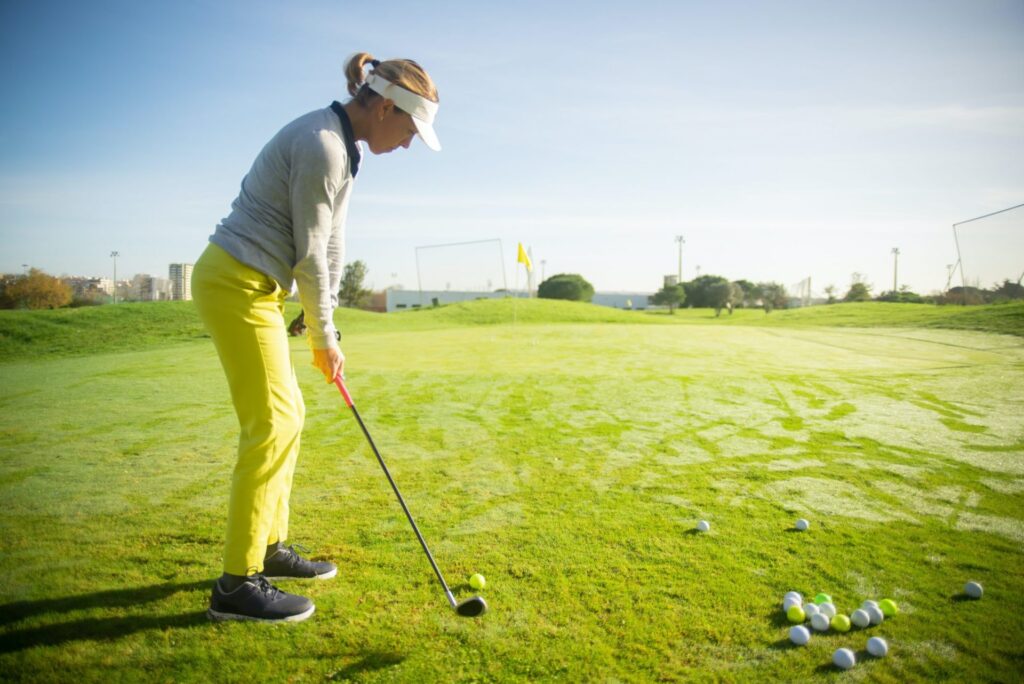The vexing issue of slicing the golf ball is a common frustration among golfers, spanning both novices and seasoned players alike. This troublesome shot begins its journey left of the intended target and continues its relentless curve, frequently finding its way into the rough or even out of bounds. But worry not, for as an experienced golfer, I’m here to assist you in learning how to stop slicing the golf ball once and for all.
In this comprehensive guide, we will explore the key factors that contribute to slicing the golf ball and provide practical solutions to help you strengthen your grip, correct your swing path, and achieve a straighter, more consistent ball flight.
Understanding the Slice
Before we dive into the solutions, let’s first understand what causes the dreaded slice.

What is a Golf Slice?
A slice occurs when the ball starts left of your target (for right-handed golfers) and curves even further to the right during its flight. This happens because of a combination of factors involving your grip, swing path, and clubface position at impact.
Key Terms to Know
To fully grasp the concept of fixing your slice, familiarize yourself with the following key terms:
- Strengthen Your Grip: Adjusting your hand grip on the club to minimize the tendency to slice.
- Swing Path: The direction in which your clubhead travels during your swing.
- Clubface at Impact: The angle of the clubface when it makes contact with the ball.
- Open Clubface: When the clubface is pointing right of the target for right-handed golfers, contributing to a slice.
Diagnosing the Slice
Before you can fix your slice, it’s crucial to diagnose the specific issues in your swing. Here’s a step-by-step guide to help you identify the root causes.
Step 1: Check Your Grip
1.1. Hand Grip: Ensure your left hand (for right-handed golfers) is placed on the club in a strong, firm position. Your left hand should be turned slightly to the right, allowing you to see two to three knuckles.
1.2. Right Hand: Your right hand should complement your left hand grip. It should sit comfortably below your left hand, with the V between your thumb and forefinger pointing towards your right shoulder.
Step 2: Analyze Your Swing Path
2.1. Recording Your Swing: Use video recording (as seen in the reference sources) to capture your swing from different angles. This will help you analyze your swing path accurately.
2.2. Identifying the Issue: Look for signs of an over-the-top swing, where your clubhead approaches the ball from outside the target line. This path can lead to a slice.
Step 3: Assess Your Clubface Position
3.1. Impact Position: Pay attention to where the clubface is at impact. Is it open, pointing to the right, or closed, pointing to the left?
3.2. Ball Flight: Observe the direction of your ball flight. A slice typically produces a ball flight that starts left and curves right.
Fixing Your Slice: Practical Solutions
Now that you’ve diagnosed the causes of your slice, let’s explore practical solutions to stop slicing the golf ball.
Strengthen Your Grip
Adjusting Your Hand Grip
- Rotate Your Left Hand: To strengthen your grip, rotate your left hand slightly to the right (for right-handed golfers). This allows you to see more knuckles on your left hand when looking down at your grip.
- Right Hand Support: Ensure your right hand complements your left hand by placing it comfortably below the left. The goal is to have both hands work together harmoniously.
Correct Your Swing Path
Improving Your Swing Path
- Practice Slow Swings: Begin with slow, controlled swings to ingrain the correct path. Focus on bringing the club down on a path that approaches the ball from the inside.
- Alignment Aids: Use alignment aids, such as alignment sticks, to train your body to swing on the correct path.
Adjust Your Clubface Position
Achieving the Right Clubface Position
- Alignment Check: Before each shot, take a moment to check that your clubface is square to the target. This helps avoid an open clubface position at impact.
- Impact Drills: Work on impact drills to ensure your clubface is square at the crucial moment of contact with the ball.
Hitting a Draw
Transitioning to a Draw
- Understanding the Draw: Once you’ve corrected your slice, you can learn to hit a draw intentionally. A draw is a controlled right-to-left ball flight that can be a powerful weapon in your golfing arsenal.
- Advanced Techniques: Consult your local golf pro for advanced techniques on how to intentionally hit a draw, which involves manipulating your grip and swing path.
Practice Makes Perfect
Remember that fixing your slice takes time and consistent practice. Don’t get discouraged if you don’t see immediate results. Keep working on your grip, swing path, and clubface position, and you’ll gradually reduce your tendency to slice the golf ball.
Conclusion
As an experienced golfer, I know that slicing the golf ball can be one of the most frustrating challenges on the course. However, with the right techniques and a commitment to improvement, you can conquer the slice and enjoy a more enjoyable and successful golfing experience. Strengthen your grip, correct your swing path, and achieve a consistent ball flight.
Soon, you’ll find yourself hitting the ball straighter and more confidently, leaving those slices behind for good. Happy golfing!
Now, get out on the course, put these tips into practice, and watch your game transform as you stop slicing the golf ball.
